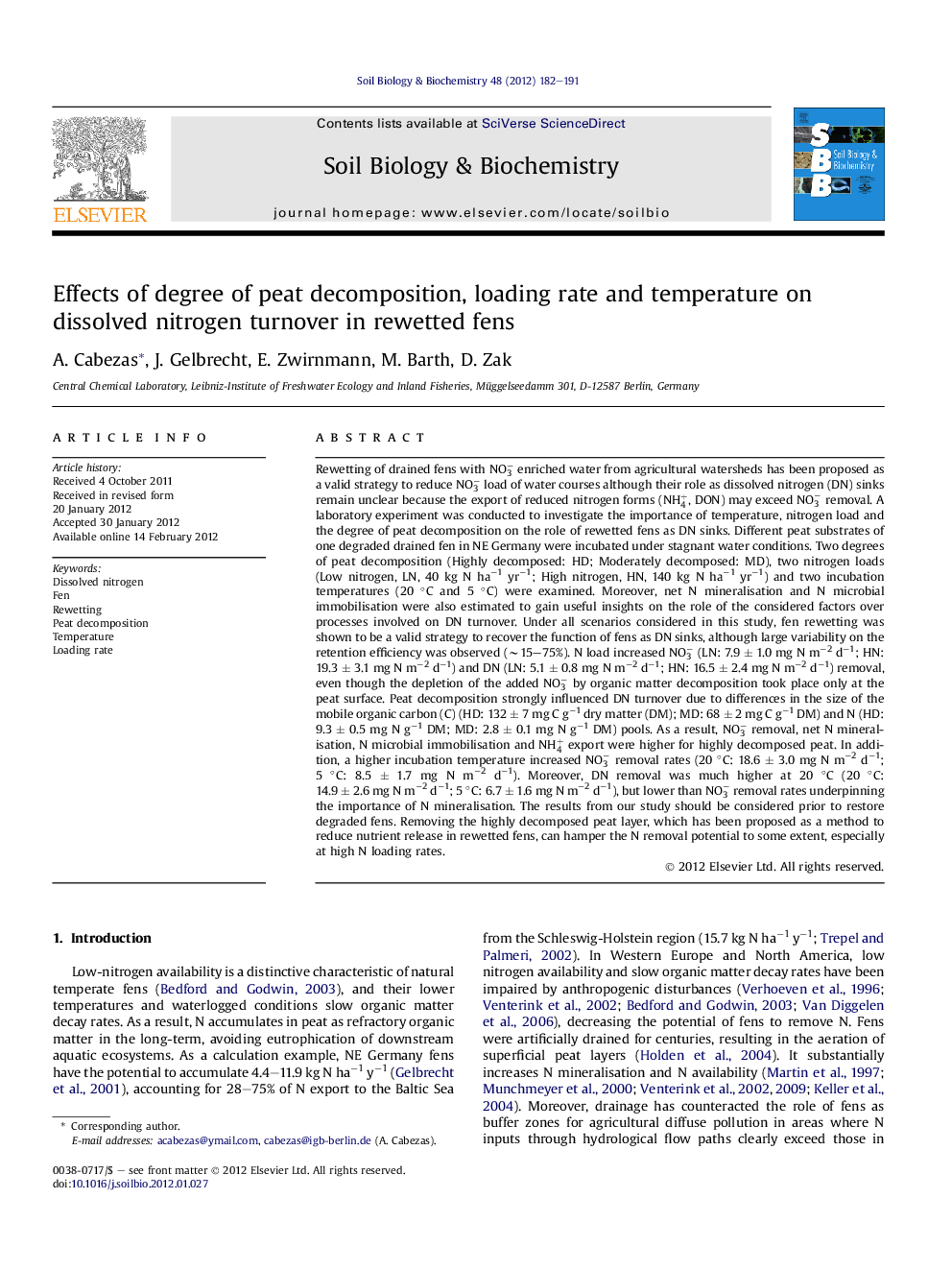| کد مقاله | کد نشریه | سال انتشار | مقاله انگلیسی | نسخه تمام متن |
|---|---|---|---|---|
| 2024948 | 1542636 | 2012 | 10 صفحه PDF | دانلود رایگان |

Rewetting of drained fens with NO3− enriched water from agricultural watersheds has been proposed as a valid strategy to reduce NO3− load of water courses although their role as dissolved nitrogen (DN) sinks remain unclear because the export of reduced nitrogen forms (NH4+, DON) may exceed NO3− removal. A laboratory experiment was conducted to investigate the importance of temperature, nitrogen load and the degree of peat decomposition on the role of rewetted fens as DN sinks. Different peat substrates of one degraded drained fen in NE Germany were incubated under stagnant water conditions. Two degrees of peat decomposition (Highly decomposed: HD; Moderately decomposed: MD), two nitrogen loads (Low nitrogen, LN, 40 kg N ha−1 yr−1; High nitrogen, HN, 140 kg N ha−1 yr−1) and two incubation temperatures (20 °C and 5 °C) were examined. Moreover, net N mineralisation and N microbial immobilisation were also estimated to gain useful insights on the role of the considered factors over processes involved on DN turnover. Under all scenarios considered in this study, fen rewetting was shown to be a valid strategy to recover the function of fens as DN sinks, although large variability on the retention efficiency was observed (∼15–75%). N load increased NO3− (LN: 7.9 ± 1.0 mg N m−2 d−1; HN: 19.3 ± 3.1 mg N m−2 d−1) and DN (LN: 5.1 ± 0.8 mg N m−2 d−1; HN: 16.5 ± 2.4 mg N m−2 d−1) removal, even though the depletion of the added NO3− by organic matter decomposition took place only at the peat surface. Peat decomposition strongly influenced DN turnover due to differences in the size of the mobile organic carbon (C) (HD: 132 ± 7 mg C g−1 dry matter (DM); MD: 68 ± 2 mg C g−1 DM) and N (HD: 9.3 ± 0.5 mg N g−1 DM; MD: 2.8 ± 0.1 mg N g−1 DM) pools. As a result, NO3− removal, net N mineralisation, N microbial immobilisation and NH4+ export were higher for highly decomposed peat. In addition, a higher incubation temperature increased NO3− removal rates (20 °C: 18.6 ± 3.0 mg N m−2 d−1; 5 °C: 8.5 ± 1.7 mg N m−2 d−1). Moreover, DN removal was much higher at 20 °C (20 °C: 14.9 ± 2.6 mg N m−2 d−1; 5 °C: 6.7 ± 1.6 mg N m−2 d−1), but lower than NO3− removal rates underpinning the importance of N mineralisation. The results from our study should be considered prior to restore degraded fens. Removing the highly decomposed peat layer, which has been proposed as a method to reduce nutrient release in rewetted fens, can hamper the N removal potential to some extent, especially at high N loading rates.
► Fen rewetting reduce NO3− fluxes.
► A lab experiment was conducted to test if rewetting reduce dissolved Nitrogen (DN) fluxes.
► Peat decomposition, N loading rate and Temperature influence DN removal.
► Nitrate removal was always higher than the export of reduced N forms (NH4+, DON).
► Future field experiments should consider our findings.
Journal: Soil Biology and Biochemistry - Volume 48, May 2012, Pages 182–191